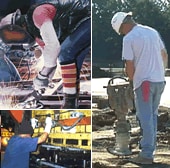Upper Limb Musculoskeletal Disorders Consortium

Upper Limb Musculoskeletal Disorder Consortium
In 2000, NIOSH started a collaborative research program to prevent work-related upper limb musculoskeletal disorders (MSD’s, conditions involving the nerves, tendons, muscles, and supporting structures of the upper limb). The program has research partners at six universities and one state agency. The goal of the program is to determine the risk for work-related:
- carpal tunnel syndrome
- tendinitis of the forearm and wrist
- shoulder disorders
MSD risk is measured based on:
- hand activity level
- amount of forceful exertion required
- awkward postures
- hand-transmitted vibration
The studies from this collaboration have considered individual MSD risk factors, including age, gender, body mass index (weight in relation to height), and medical conditions such as diabetes and thyroid disorders.
To date, the studies have included more than 4,000 workers in healthcare, manufacturing, agriculture, forestry, and construction settings. These studies will:
- determine the level of physical job demands that increase upper limb MSD’s
- see if exposure predicts health outcomes
- guide prevention practices
